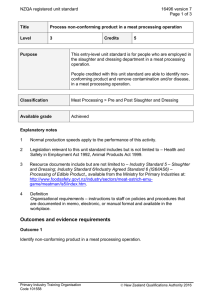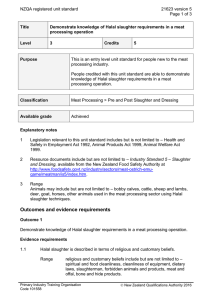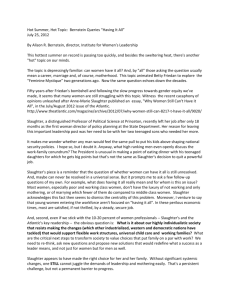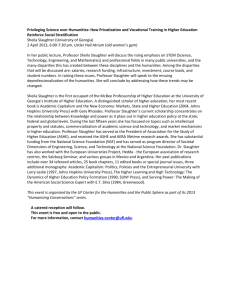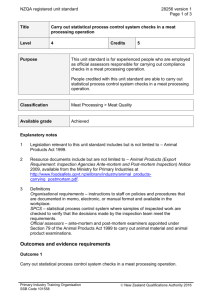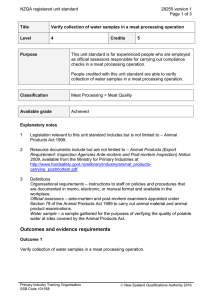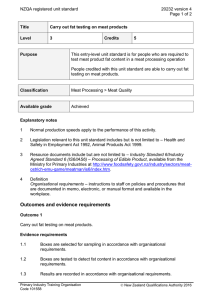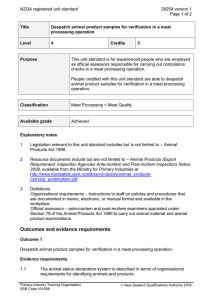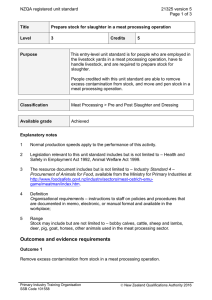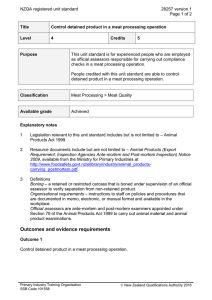NZQA registered unit standard 23352 version 4 Page 1 of 3
advertisement
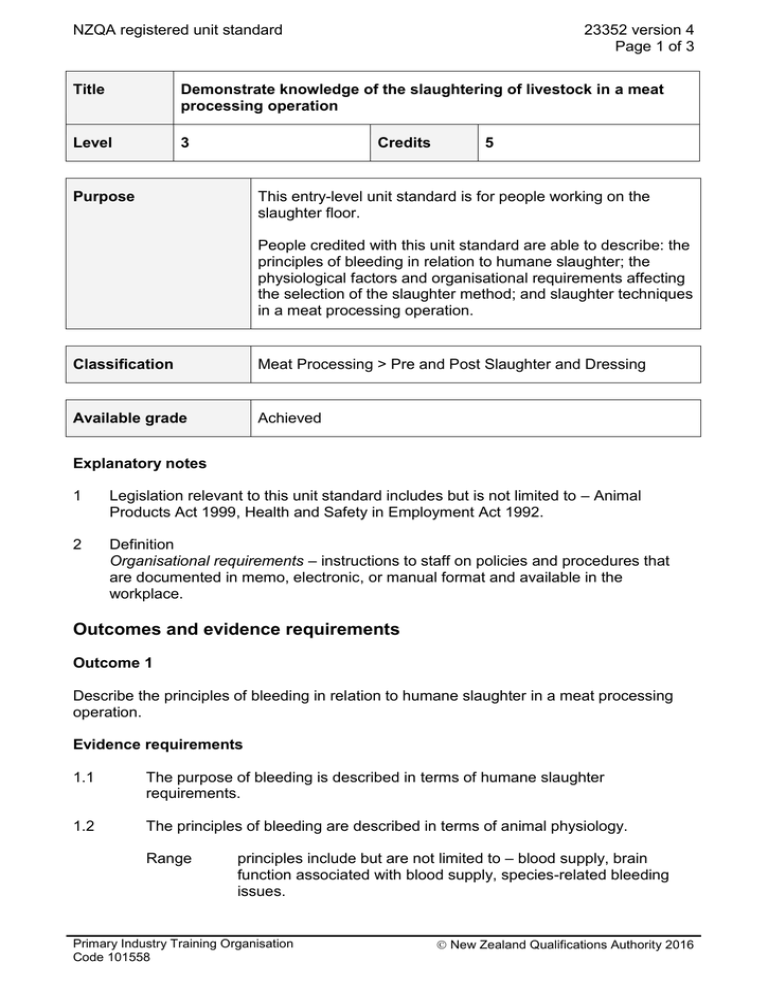
NZQA registered unit standard 23352 version 4 Page 1 of 3 Title Demonstrate knowledge of the slaughtering of livestock in a meat processing operation Level 3 Credits Purpose 5 This entry-level unit standard is for people working on the slaughter floor. People credited with this unit standard are able to describe: the principles of bleeding in relation to humane slaughter; the physiological factors and organisational requirements affecting the selection of the slaughter method; and slaughter techniques in a meat processing operation. Classification Meat Processing > Pre and Post Slaughter and Dressing Available grade Achieved Explanatory notes 1 Legislation relevant to this unit standard includes but is not limited to – Animal Products Act 1999, Health and Safety in Employment Act 1992. 2 Definition Organisational requirements – instructions to staff on policies and procedures that are documented in memo, electronic, or manual format and available in the workplace. Outcomes and evidence requirements Outcome 1 Describe the principles of bleeding in relation to humane slaughter in a meat processing operation. Evidence requirements 1.1 The purpose of bleeding is described in terms of humane slaughter requirements. 1.2 The principles of bleeding are described in terms of animal physiology. Range principles include but are not limited to – blood supply, brain function associated with blood supply, species-related bleeding issues. Primary Industry Training Organisation Code 101558 New Zealand Qualifications Authority 2016 NZQA registered unit standard 23352 version 4 Page 2 of 3 Outcome 2 Describe the physiological factors and organisational requirements affecting the selection of the slaughter method in a meat processing operation. Evidence requirements 2.1 Physiological factors affecting the slaughter method are described in terms of the Animal Welfare Act. factors include but are not limited to – handling, method of stunning, restraint, stun to stick interval. Range 2.2 The selection of the slaughter method is described in terms of organisational requirements. selection include but is not limited to – includes but is not limited to – Halal or non-Halal, capital and running costs, operator safety and ease of operation, versatility, effects on carcase quality, market requirements. Range Outcome 3 Describe slaughter techniques in a meat processing operation. Evidence requirements 3.1 Ritual slaughter is described in terms of religious requirements. ritual slaughter includes but is not limited to – Halal and Kosher slaughter. Range 3.2 Differences between ritual and non-ritual slaughter are described. 3.3 The species and welfare issues that impact on the application of the ritual slaughter methods are described in terms of organisational requirements. impact includes but is not limited to – species physiology. Range Planned review date 31 December 2019 Status information and last date for assessment for superseded versions Process Version Date Last Date for Assessment Registration 1 27 October 2006 31 December 2012 Review 2 21 July 2011 31 December 2018 Review 3 27 January 2015 N/A Revision 4 17 September 2015 N/A Primary Industry Training Organisation Code 101558 New Zealand Qualifications Authority 2016 NZQA registered unit standard 23352 version 4 Page 3 of 3 Consent and Moderation Requirements (CMR) reference 0033 This CMR can be accessed at http://www.nzqa.govt.nz/framework/search/index.do. Please note Providers must be granted consent to assess against standards (accredited) by NZQA, before they can report credits from assessment against unit standards or deliver courses of study leading to that assessment. Industry Training Organisations must be granted consent to assess against standards by NZQA before they can register credits from assessment against unit standards. Providers and Industry Training Organisations, which have been granted consent and which are assessing against unit standards must engage with the moderation system that applies to those standards. Requirements for consent to assess and an outline of the moderation system that applies to this standard are outlined in the Consent and Moderation Requirements (CMR). The CMR also includes useful information about special requirements for organisations wishing to develop education and training programmes, such as minimum qualifications for tutors and assessors, and special resource requirements. Comments on this unit standard Please contact the Primary Industry Training Organisation standards@primaryito.ac.nz if you wish to suggest changes to the content of this unit standard. Primary Industry Training Organisation Code 101558 New Zealand Qualifications Authority 2016
